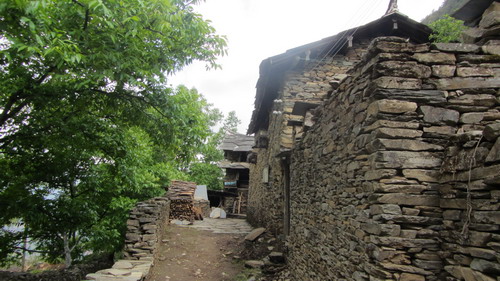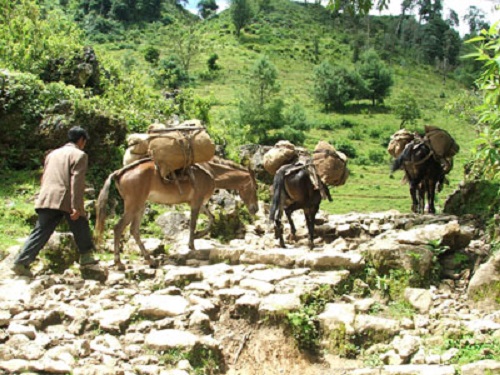Tangfang Stone Village in Fengqing County, Lincang
Chinese Name: 凤庆鲁史镇塘房村
English Name: Tangfang Stone Village in Fengqing County, Lincang
Region: Lincang City, Yunnan Province, China
Specific Location: Hehe Village, Lushi Town, Fengqing County
Distance: Approximately 20 kilometers from Lushi Town
Historical Significance
Tea Horse Road: Tangfang Village is an integral part of the ancient Tea Horse Road, a historic trade route that connected China with Tibet and other regions. This route was crucial for the trade of tea and horses, as well as other goods, between China and its neighboring regions.
Cultural Heritage: The village is recognized as a national historical and cultural heritage site and is one of China’s ancient traditional villages. It served as a significant resting place for caravans, travelers, and merchants, contributing to its historical name.
Architectural Features
Stone Construction:
- Traditional Stone Houses: The village’s architecture features houses constructed from stone slabs, including the roofs, walls, and foundations. Stone elements are prevalent throughout, including doorposts, courtyards, and various tools.
- Stone Paths and Features: The village is characterized by stone-paved roads, stone water channels, garden ridges, and numerous stone artifacts like troughs, basins, benches, and mills. Even tools for roasting tea and cooking are made of stone.
Cultural and Economic Aspects
Tea Production:
- Green Stone Slab Tea: Tangfang Village is known for its tea production, particularly the green stone slab tea. This tea-making tradition reflects the village’s historical connection to the Tea Horse Road.
- Historical Tea Trade: The village’s tea trade has historical roots, with stories of merchants buying tea at high prices and villagers receiving tea seeds from traders.
Local Traditions:
- Tea Culture: The village’s daily life includes traditional tea practices, with breakfast often consisting of tea rather than fried dishes. Local elderly people are skilled in brewing Baidou Tea, a traditional tea from the area.
Tourism and Preservation
Scenic Beauty:
- Natural Environment: The village is surrounded by beautiful natural scenery, with ancient trees and stone buildings that blend harmoniously with the landscape. It was listed as one of China’s top 100 summer resorts in 2014 and is among the first ten low-carbon “Hengchun Towns” in Lincang City.
Tourist Appeal:
- Preservation and Attractions: Tangfang Village has preserved a well-maintained section of the Tea Horse Road, with visible hoofprints and historical remnants. Despite its somewhat desolate appearance today, it continues to attract visitors interested in its historical charm and stone architecture.
Historical and Modern Context
Tea Horse Road Legacy:
- Historical Route: The “Shunxia Line,” part of the Tea Horse Road from Shunning (Fengqing County) to Xiaguan, was a major route for tea trade before 1913. Tangfang Village was an important stop for resting horses and trading goods.
Modern Changes:
- Decline and Revival: Although the caravan trade along the Tea Horse Road has declined, and local horse caravans are no longer active, the village’s traditional charm and tea-making culture continue to attract tourists.
Tourism Impact:
- Visitor Experience: Visitors to Tangfang Village can experience traditional stone architecture, enjoy locally brewed tea, and appreciate the village’s historical significance. The growing popularity of tourism is expected to further revitalize the village.
Unique Characteristics
Architectural Structure:
- Stone and Wood Construction: The stone slab houses appear entirely made of stone externally, but they are supported by wooden frameworks. This structural combination ensures that the houses remain comfortable in varying weather conditions.
Local Climate and Comfort:
- Climate Adaptability: The stone slab houses offer warmth in winter and coolness in summer, contributing to the village’s appeal. Despite modern attempts to replicate its architecture elsewhere, the unique atmosphere of Tangfang Village remains unmatched.
Tangfang Village stands as a remarkable example of historical preservation and traditional culture, continuing to captivate visitors with its rich heritage and picturesque setting.
There is a beautiful ,quiet, and peaceful village in Fengqing Lushi Town which is called Tangfang Village. It was one of the important stops along the Tea Horse Ancient Road and about 11 kilometers from Lushi Town. On the curved mountain way to Lushi Town, you can see many cows and sheep, also the walnut trees everywhere.
On arriving in Tangfang Village, rare Stone House can be seen everywhere as well.
The Stone Village enjoys a well reputation——the village on the stones.
Obviously, the walls were built by stone, and the roof was built by thin slate. Walnut trees, stone houses, and vegetable fields add radiance and charm to each other.

Tangfang Village is a place with about 700 years history along the Tea House Ancient Road. In ancient times, caravan carried tea, walnut, and herb passed here.

Tangfang Village is a paradise ,a stone world ,and the most beautiful village in Fengqing County.The stone walls , chicken, magnolia, peach blossom and palm trees here forms a unique natural landscape.The elegant white camellia is in blooms ,welcome to visit the tranquil village and experience our tranquil stone village.














